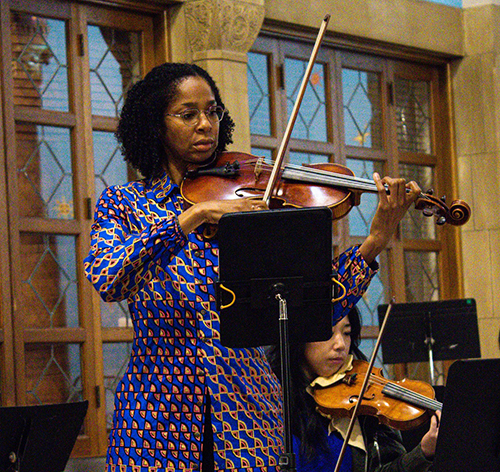by Daniel Hathaway

Having already taken their interesting program of works by J.S. Bach, Margaret Brouwer, and Johannes Brahms to Fairmount Presbyterian Church in Cleveland Heights, St. Noel Church in Willoughby Hills, and the Shrine Church of St. Stanislaus in Slavic Village, CityMusic ended its most recent progress around town at Our Lady of Angels in Rocky River on Sunday afternoon, October 27. The performance attracted a large audience.
As any musician who has taken concerts on the road knows, gains in accessibility for the audience can result in the loss of control over details — like acoustics. OLA is a large space with a vaulted ceiling that ends in a semi-circular apse. In the absence of carpeting and pew cushions, sound ricochets off the hard surfaces and shrouds music in a halo — a nice feature in a religious building, but not so agreeable for counterpoint like that of Bach’s Sixth Brandenburg Concerto that began the performance on Sunday.
Still, violists Eliesha Nelson and Jonathan Bagg, cellists Joel Becktell and Helen Hawersaat (playing the gamba parts on cellos), cellist Jane Leggiero, bassist Tracy Rowell, and harpsichordist Elizabeth DeMio set a relaxed tempo, played with fine ensemble without a conductor, and produced beautiful sounds. It was fun to sense the audience’s recognition of the third movement as the American Public Media theme song.

Eliesha Nelson was a superb soloist, pulling a wonderful tone that carried through the colorful orchestral texture, replete with percussion, chimes, and mallet instruments. Her spirited cadenza was a high point of the opening movement, which ends with a reference to the lyrical Gregorian melody Ubi caritas.
“Simply a love song,” wrote Brouwer in her second movement notes, which go on to describe its solo viola melody as one that “exudes warmth, pleasure, and delight.”
Brouwer (pictured) obviously enjoys writing final movements that take off on unexpected tacks, and in this case, “Blithesome Spirit” becomes “buoyantly playful, mischievous, and sometimes a bit jaunty.” Snap pizzicati in cellos and basses, sharp, short notes in the solo viola, percussion interjections, and finally a big brass moment set up a fast slide to the end.
At this point in the concert, it became clear that another venue element beyond CityMusic’s reach was climate control — the church had become decidedly chilly.
Following intermission, all went well in the first three movements of Brahms’s Serenade No. 2 — the beautiful Allegro moderato opening, the lively but sanely-paced Scherzo, and the Adagio non troppo, which gave both winds and low strings great opportunities to shine. Then, six o’clock came and the church’s electronic carillon began tolling the Angelus a microtone away from the final note.
Everybody waited patiently as the device went on to play several stanzas of a hymn tune (“Pleading Savior,” familiar enough that some audience members began humming along).
Finally, Lopez raised his baton for the third time, and Brahms continued with the Quasi menuetto — a nice walk in the woods — and the fun concluding Rondo with its melody you didn’t mind hearing over and over again.
Published on ClevelandClassical.com November 7, 2024
Click here for a printable copy of this article



